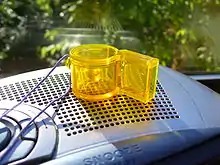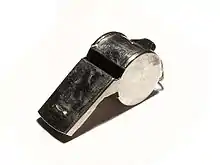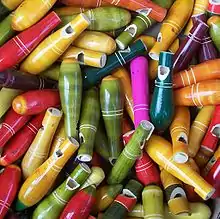Whistle
A whistle is an instrument which produces sound from a stream of gas, most commonly air. It may be mouth-operated, or powered by air pressure, steam, or other means. Whistles vary in size from a small slide whistle or nose flute type to a large multi-piped church organ.


Whistles have been around since early humans first carved out a gourd or branch and found they could make sound with it. In prehistoric Egypt, small shells were used as whistles.[1] Many present day wind instruments are inheritors of these early whistles. With the rise of more mechanical power, other forms of whistles have been developed.
One characteristic of a whistle is that it creates a pure, or nearly pure, tone. The conversion of flow energy to sound comes from an interaction between a solid material and a fluid stream. The forces in some whistles are sufficient to set the solid material in motion. Classic examples are Aeolian tones that result in galloping power lines, or the Tacoma Narrows Bridge (the so-called "Galloping Gertie" of popular media). Other examples are circular disks set into vibration.[2]
Depending on the geometry, there are two basic types of whistles: those that generate sound through oscillations of fluid mass flow, and those that generate sound through oscillations of the force applied to the surrounding medium.
History
Early whistles

Whistles made of bone or wood have been used for thousands of years.
Whistles were used by the Ancient Greeks to keep the stroke of galley slaves. The English used whistles during the Crusades to signal orders to archers. Boatswain pipes were also used in the age of sail aboard naval vessels to issue commands and salute dignitaries.[3]
Joseph Hudson
Joseph Hudson set up J Hudson & Co in Birmingham, UK in 1870. With his younger brother James, he designed the 'Acme City' brass whistle. This became the first referee whistle used at association football matches during the 1878–79 Football Association Cup match between Nottingham Forest and Sheffield. Prior to the introduction of the whistle, handkerchiefs were used by the umpires to signal to the players.[4]
In 1883 he began experimenting with pea-whistle designs that could produce an intense sound that could grab attention from over a mile away. His invention was discovered by accident, when he accidentally dropped his violin and it shattered on the floor. Observing how the discordant sound of the breaking strings travelled (trill effect), Hudson had the idea to put a pea in the whistle.[4] Prior to this, whistles were much quieter, and were only thought of as musical instruments or toys for children. After observing the problems that local police were having with effectively communicating with rattles,[5][6] he realised that his whistle designs could be used as an effective aid to their work.[7]
Hudson demonstrated his whistle to Scotland Yard and was awarded his first contract in 1884. Both Ratchet rattles and whistles were used to call for back-up in areas where neighbourhood beats overlapped, and following their success in London, the whistle was adopted by most police in the United Kingdom (UK).
This police whistle monopoly gradually made Hudson the largest whistle manufacturer in the world, supplying police forces and other general services everywhere. His whistle is still used by many forces worldwide. His design, was improved as the 'Acme Thunderer', the first ever pea whistle, which remains the most used whistle in the world; for train guards, dog handlers and police officers. From the 1880s and 1890s, J. Hudson & Co began facing greater competition, as other whistle manufacturing companies were established, including W. Dowler & Sons, J. Barrall, R. A. Walton, H. A. Ward and A. De Courcy & Co. In 1987, Ron Foxcroft released the Fox 40 pealess whistle, designed to replace the pea whistle and be more reliable.
Typical sources and uses
Human whistling unaided by any instrument can be used for musical recreation or as a whistled language for communication over distances too great for articulate speech, among many other purposes. Musical instruments include the nose whistle or nose flute, the tin whistle and the slide whistle. Since a whistle produces a loud sound that carries over a great distance, whistles are useful for signalling. On ships, the boatswain's call is used to alert members of the crew. A dog whistle can be used to train a dog for hunting, herding, or other occupations. Industrial plants often use a steam whistle to signal shift changes or to give alarms of emergencies; steam locomotives were equipped with train whistles for warning and signalling. A small-scaled steam whistle is found on a whistling kettle, to alert the user that the water is boiling. Storage tanks may be equipped with a whistle vent which sounds continually as the tank is being filled; when the tank level covers the vent pipe, the whistle stops and the tank is full.
They also occur as accidental byproducts of fluid flow such as supersonic jets, cavity resonances, whistling telephone wires, and idling circular saws.
See also
- Vessel flute (acoustics of whistles and tunable whistles)
- Low whistle (low-pitched tinwhistle or flageolet)
- Liquid whistle (mixes fluids)
- Physics of whistles
- Firedamp whistle (for detecting methane in mines)
- Whistler (radio) (very low frequency radio feature caused by lightning and atmospheric effects)
- Rossby whistle (climate oscillation of the Caribbean)
References
- Arroyos, Rafael Pérez (2003). Egypt: Music in the Age of the Pyramids (1st ed.). Madrid: Centro de Estudios Egipcios. p. 28. ISBN 978-8493279615.
- Chanaud, Robert C. (1970). "Observations of Oscillatory Radial Flow between a Fixed Disk and a Free Disk". The Journal of the Acoustical Society of America. 47 (5B): 1471–2. doi:10.1121/1.1912065.
- "Whistle". How Products are Made. Retrieved 22 January 2018.
- "History of the Whistle". Gdfra.org.au. Retrieved 12 January 2021.
- Cross, David (2011-02-17). "On the Beat in Birmingham - Rules and regulations". BBC. Retrieved 11 March 2014.
Police whistles came much later; the early Victorian constable would have carried a small wooden rattle.
- Taylor, J. "The Victorian Police Rattle Mystery" The Constabulary (2003) Archived February 18, 2010, at the Wayback Machine
- "The First Whistle". Acmewhistles.co.uk. Retrieved 12 January 2021.
External links
 Media related to whistles at Wikimedia Commons
Media related to whistles at Wikimedia Commons The dictionary definition of whistle at Wiktionary
The dictionary definition of whistle at Wiktionary- Chisholm, Hugh, ed. (1911). . Encyclopædia Britannica. 28 (11th ed.). Cambridge University Press. pp. 595–596.
- Whistle (Polish folk musical instruments)

